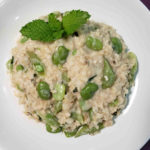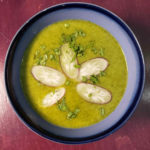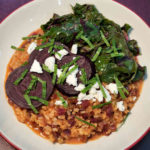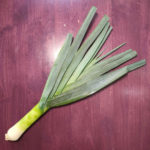The Pork
Tuscan Bean and Greens Soup is a cousin to Caldo Verde with the prime difference being the choice of flavoring meat. Where Caldo Verde uses a smokey pork sausage, this soup uses cured pork. In Tuscany, pancetta (cured pork belly) or guanciale (cured pork jowl) would be the go-to flavoring meat options. Those work great, so feel free to use them. But, in the US, bacon is much easier to find. Bacon is related to pancetta in that they are both cured pork belly, but bacon is smoked while pancetta is not. If you choose the bacon route, the nuance of smoke will make this soup even more like Caldo Verde, but the addition of Parmesan will make it distinct.
The Greens
Really, it’s whatever greens you have. Preferably fresh and seasonal. Seriously, do an internet search on “tuscan X and bean soup,” replacing X with kale or chard or spinach or escarole. With each, you will find several links to very similar recipes. I’ve used all of these greens, and I’ve used collard greens. They all work nicely, each bringing their own nuances. The lesson here, don’t get committed to particular ingredients in recipes. As you cook with ingredients, pay attention to how they cook and how they taste. Use that experience to inform substitutions in recipes or to whip up dishes intuitively, without a recipe to fall back on.
The Beans
Cannellini beans are the main choice here, but other white beans such as navy or great northern can work if that’s what you have. Cannellini are the largest of the white bean options and most commonly used in Italian dishes. This soup is nice with either canned or dried beans. In the recipe I’ll specify canned beans, due to their convenience. If you prefer to work with dried beans, I’m sure you know how to soak and cook them and how to substitute them in recipes which call for canned. An alternative would be to replace a can of beans with three ounces of a small dried pasta, such as ditalini, and the soup will become a form of pasta e fagioli.
The Soffritto
Like many Italian dishes, this Tuscan Bean and Greens Soup starts with a soffritto for the aromatic base. Traditionally this is finely chopped onion, carrots and celery, sautéed in olive oil. I will specify that combination in the recipe. But, again, you can substitute. If you don’t have celery, make it with just onions and carrots. If you’d like to try it with leeks instead of onions, go for it.
Other Components
Once the soffritto has sautéed to a softened state, a little bit of minced garlic is added, because, of course, it’s garlic. And then you make a well in the middle of the soffritto, exposing the bare pan beneath, where you add in a couple tablespoons of tomato paste. The tomato paste isn’t to add a tomato flavor to the dish, but instead to add umami. Letting the tomato paste sizzle a little bit on its own helps with that. Of course, this is a soup dish, so it needs a lot of liquid. Generally, this is in the form of stock. Here, a store-bought chicken stock is my choice. You don’t want this to taste like chicken soup, so a nice homemade stock will likely overpower. A less potent quart of stock from the grocery fits the bill nicely. You need an herbal element. I usually use a teaspoon of dried oregano, and that’s what I specify in the recipe. But again, substitution is totally OK. A teaspoon of dried thyme or a bay leaf would work equally as well. Rosemary would make an interesting option. And finally, some grated parmesan cheese. This really finishes the dish. You don’t need much. About an ounce by weight for an entire pot is great. If you use too much, you’ll likely find a layer of cheese stuck to the bottom of the pot when you clean things up.
Oh, don’t forget some warm crusty bread! There’s nothing like dipping warm crusty bread into the broth of this soup!
One Final Trick
When the soup is done and ready to serve, if you would prefer a thicker broth, do this: Scoop out a cup of soup, including a lot of beans and broth. Return any greens to the pot. Use an immersion blender to puree the cup of soup, and then stir this puree back into the pot.
Make it a Meal!
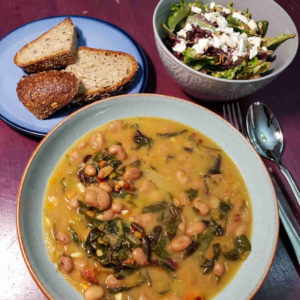
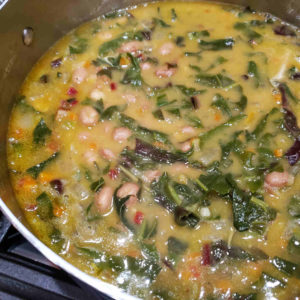
Tuscan Bean and Greens Soup
Ingredients
- Olive Oil
- 2 oz Pancetta, Guanciale, or Bacon
- 1 Medium Onion (6-8 oz) diced
- 1 Medium Carrot (about 3 oz) diced
- 1 Celery Stalk diced
- 2-3 Cloves of Garlic (15 grams) minced
- 2 tbsp Tomato Paste
- 4 cups Chicken Broth
- 1 tsp Dried Oregano
- 6-8 oz Greens (Kale, Escarole, Chard, etc) roughly chopped
- 3 15 oz cans white beans such as cannellini
- 1 oz Parmesan Cheese finely grated
- Salt and Pepper
Instructions
- Slice the cured pork into small, matchstick thick, pieces
- Heat a soup pot over medium heat. Add the pork and stir in some olive oil. A tablespoon is probably enough. You want to make the pork and the pot bottom glisten, but you don't want a pool of oil. Sauté until the pork has visibly rendered it's fat. Expect about 5 minutes.
- Add the onion, carrot and celery to the pot along with some salt (about 1 tsp). Stir. If the aromatics glisten, then there is enough fat. If they appear dry, add another splash of olive oil. Increase the heat to medium-high and sauté, stirring frequently, until the carrots are soft and the onions are translucent. Expect 4-5 minutes.
- Add the garlic and stir into the aromatic mixture. Make an open well in the center of the pan and add the tomato paste directly on the metal of the pan. Let the tomato paste sizzle on it's own for a minute and then stir everything back together.
- If a fond (browned bits stuck to the bottom of the pot) has developed, start with a good splash of the broth to deglaze the pot, scraping with a wooden spatula.
- Add the remaining stock and the greens and the beans to the pot. Turn the heat on high until it boils. Turn down to a simmer and let simmer for 15-20 minutes.
Notes
- You can thicken the soup by taking a cup of soup, with plenty of beans and put into a wide mouthed mason jar. Return any greens back to the pot and use a stick blender to transform that cup of soup into a goopy puree. Mix that back into the pot.

